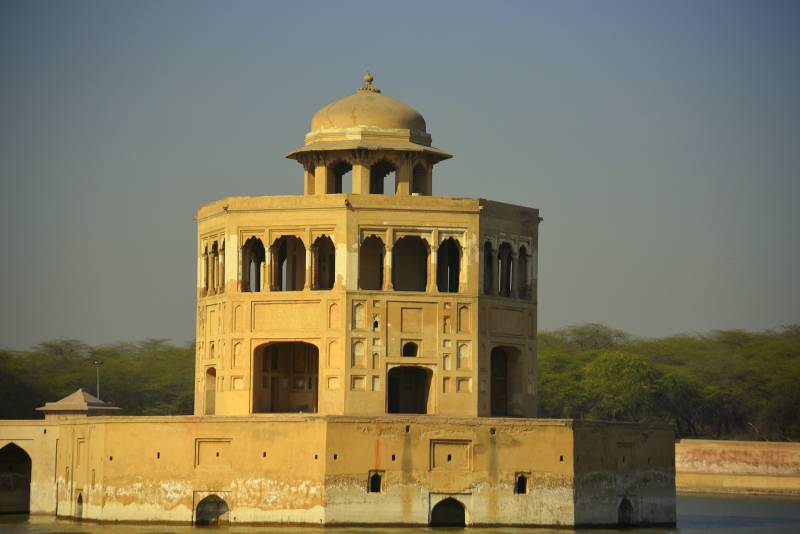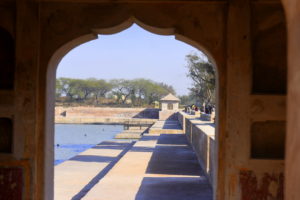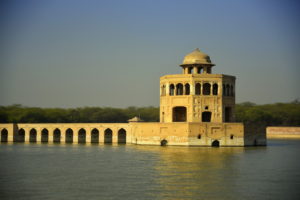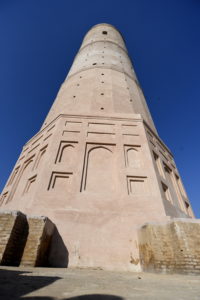
If we look at the picture wall of Lahore Fort, we see some scenes of the Mughal era in which different hobbies and activities of the kings are depicted. We see that elephants, camels, deer and horses are seen in different styles. The life of Mughals revolved around love and affection, whether that was for throne, buildings, personalities or animals. Today let me tell you about another marvelous memory of the Mughals about which people do not know much and take it is a leisure place built by the Mughals. I’m talking about the Hiran Minar.
This thirty meters high and ten meters wide tower at its base known as Hiran Minar, means tower for deer as Hiran means deer and Minar is a tower. Although it is one of the most visited places in Sheikhupura, a city in Pakistan’s province Punjab but the background or the story of this place is not much talked about.

You must be thinking that what a deer had to do with a tower. Well, this is a grave of a deer! It is said that the top of the tower has the dead body of the deer called ‘Mansraj’. Around the perimeter are 214 holes that according to historic references were used as supports for the cut off heads of animal trophies taken by the emperor.
So who was the deer? This deer had an association with Mughal Emperor Jahangir who loved hunting. According to the historians and other accounts we get to know that Jahangir, on a fine morning, expressed his desire to go for hunting and thus his paraphernalia was packed and the entourage took its way to Sheikhupura. Jahangir was accompanied by his friends and the dearest deer Mansraj (meaning - Light of the Mind). The Emperor loved the deer.

One day Jahangir was chasing a few other deer while hunting and as he liked one he set the target on it. Unfortunately and unintentionally, Jahangir killed his own deer pet Mansraj. He killed his own deer by mistake but the incident led Jahangir into a lifetime trauma and sadness. The deer Mansraj fell on the ground bleeding and crying with pain and died after a few minutes and left the emperor into tears.
So the same place where the deer died, upon the orders of the Emperor, a huge tower was built which today is known as “Hiran Minar”. So this is how the tower was built and till now stands there a mark of love Emperor Jahangir had for his pet.
Since 1607 this tower stands as an emblem of love at Sheikhupura and it is also said that the Sheikhupura City was founded by Jahangir in 1606 -7 and today it is the 16th largest city in Pakistan. The place where this city stands was one of Jahangir’s princely territories during his father Emperor Akbar’s time. Jahangir declared the desolate jungles as royal hunting ground. Here is another act of love that after the death of deer Mansraj, this hunting ground was changed into a safe land and hunting was prohibited.

It is said that in 1634, Jahangir’s successor Shah Jahan visited his father’s desired hunting place and decided to add to the complex by constructing a huge water tank and octagonal pavilion to the east of the commemorative tower. The rectangular water tank measures 750 feet by 895 feet and features a refined series of channels and catchment basins to maintain the water level. Brick ramps in the middle of each side of the tank provide access to the water for animals living in the preserve. The pavilion's architecture is similar to the Sher Mandal at Delhi's Purana Qila built earlier by Emperor Humayun.
The buildings of Mughal era were built with lime mortar and plaster and at Hiran Minar, the use of this material has proven that it is the best water-proof material as the monument is standing for the last 400 years where the water is touching it. It is said that the water for the pool was arranged by a canal, linking Hiran Minar with River Chenab that flowed several miles further west of the site. Today the dried up old water channels line the western sides of the monument, while a stream coming in from the opposite direction now fills the pool. There are 108 steps on a spiral staircase leading to the peak of the tower where rest the remains of Mansraj. The unique features of this particular complex are the deer's grave and the distinctive water collection system.
If we look into the history of this city we get to know that its name recorded in the Emperor's autobiography, Tuzk-e-Jahangiri, was Jehangirabad. Jahangir laid the foundation of the Sheikhupura Fort in 1607, which is situated in the city's centre but is in ruins now.
It is said that when the Sikhs came to the power in the eighteenth century they changed the name of the town from Jahangirabad to Sheikhupura. So this city along with Hiran Minar holds many other ancient monuments.
If we analyze the buildings and structures built by the Mughals, this Hiran Minar is most unique and has a different reason for construction. An extraordinary feature of Hiran Minar is its location and environment. The summit of the Minar is perhaps the best place in the province of Punjab to get a feel for the broader landscape and its relationship to a Mughal site. Hiran Minar is no doubt a marvelous stunning masterpiece of Mughal architecture. Unique in design, pattern and setting, the monument adds a splendid addition to the Mughals architecture and their love for building edifices of great strength and grandeur of noble simplicity and elegance.
This is one of the amazing sites to visit in Pakistan and if the history is displayed more obviously I am sure that the tourist will love and admire it more. I hope that the place is well maintained and made a part of the city tour at Sheikhupura.
This thirty meters high and ten meters wide tower at its base known as Hiran Minar, means tower for deer as Hiran means deer and Minar is a tower. Although it is one of the most visited places in Sheikhupura, a city in Pakistan’s province Punjab but the background or the story of this place is not much talked about.

You must be thinking that what a deer had to do with a tower. Well, this is a grave of a deer! It is said that the top of the tower has the dead body of the deer called ‘Mansraj’. Around the perimeter are 214 holes that according to historic references were used as supports for the cut off heads of animal trophies taken by the emperor.
So who was the deer? This deer had an association with Mughal Emperor Jahangir who loved hunting. According to the historians and other accounts we get to know that Jahangir, on a fine morning, expressed his desire to go for hunting and thus his paraphernalia was packed and the entourage took its way to Sheikhupura. Jahangir was accompanied by his friends and the dearest deer Mansraj (meaning - Light of the Mind). The Emperor loved the deer.

One day Jahangir was chasing a few other deer while hunting and as he liked one he set the target on it. Unfortunately and unintentionally, Jahangir killed his own deer pet Mansraj. He killed his own deer by mistake but the incident led Jahangir into a lifetime trauma and sadness. The deer Mansraj fell on the ground bleeding and crying with pain and died after a few minutes and left the emperor into tears.
So the same place where the deer died, upon the orders of the Emperor, a huge tower was built which today is known as “Hiran Minar”. So this is how the tower was built and till now stands there a mark of love Emperor Jahangir had for his pet.
Since 1607 this tower stands as an emblem of love at Sheikhupura and it is also said that the Sheikhupura City was founded by Jahangir in 1606 -7 and today it is the 16th largest city in Pakistan. The place where this city stands was one of Jahangir’s princely territories during his father Emperor Akbar’s time. Jahangir declared the desolate jungles as royal hunting ground. Here is another act of love that after the death of deer Mansraj, this hunting ground was changed into a safe land and hunting was prohibited.

It is said that in 1634, Jahangir’s successor Shah Jahan visited his father’s desired hunting place and decided to add to the complex by constructing a huge water tank and octagonal pavilion to the east of the commemorative tower. The rectangular water tank measures 750 feet by 895 feet and features a refined series of channels and catchment basins to maintain the water level. Brick ramps in the middle of each side of the tank provide access to the water for animals living in the preserve. The pavilion's architecture is similar to the Sher Mandal at Delhi's Purana Qila built earlier by Emperor Humayun.
The buildings of Mughal era were built with lime mortar and plaster and at Hiran Minar, the use of this material has proven that it is the best water-proof material as the monument is standing for the last 400 years where the water is touching it. It is said that the water for the pool was arranged by a canal, linking Hiran Minar with River Chenab that flowed several miles further west of the site. Today the dried up old water channels line the western sides of the monument, while a stream coming in from the opposite direction now fills the pool. There are 108 steps on a spiral staircase leading to the peak of the tower where rest the remains of Mansraj. The unique features of this particular complex are the deer's grave and the distinctive water collection system.
If we look into the history of this city we get to know that its name recorded in the Emperor's autobiography, Tuzk-e-Jahangiri, was Jehangirabad. Jahangir laid the foundation of the Sheikhupura Fort in 1607, which is situated in the city's centre but is in ruins now.
It is said that when the Sikhs came to the power in the eighteenth century they changed the name of the town from Jahangirabad to Sheikhupura. So this city along with Hiran Minar holds many other ancient monuments.
If we analyze the buildings and structures built by the Mughals, this Hiran Minar is most unique and has a different reason for construction. An extraordinary feature of Hiran Minar is its location and environment. The summit of the Minar is perhaps the best place in the province of Punjab to get a feel for the broader landscape and its relationship to a Mughal site. Hiran Minar is no doubt a marvelous stunning masterpiece of Mughal architecture. Unique in design, pattern and setting, the monument adds a splendid addition to the Mughals architecture and their love for building edifices of great strength and grandeur of noble simplicity and elegance.
This is one of the amazing sites to visit in Pakistan and if the history is displayed more obviously I am sure that the tourist will love and admire it more. I hope that the place is well maintained and made a part of the city tour at Sheikhupura.
